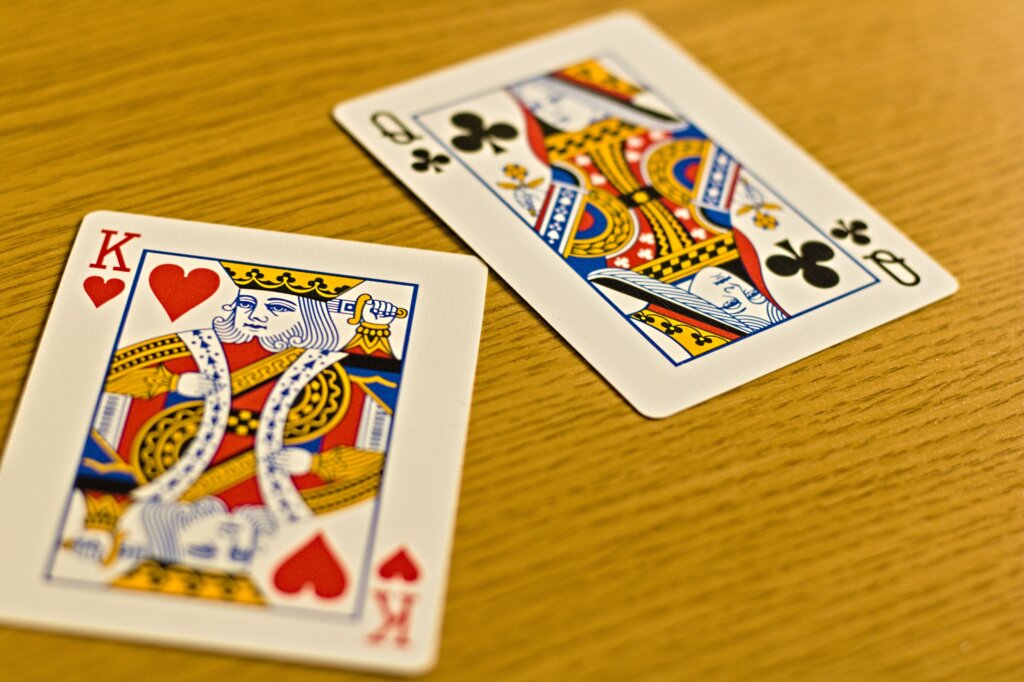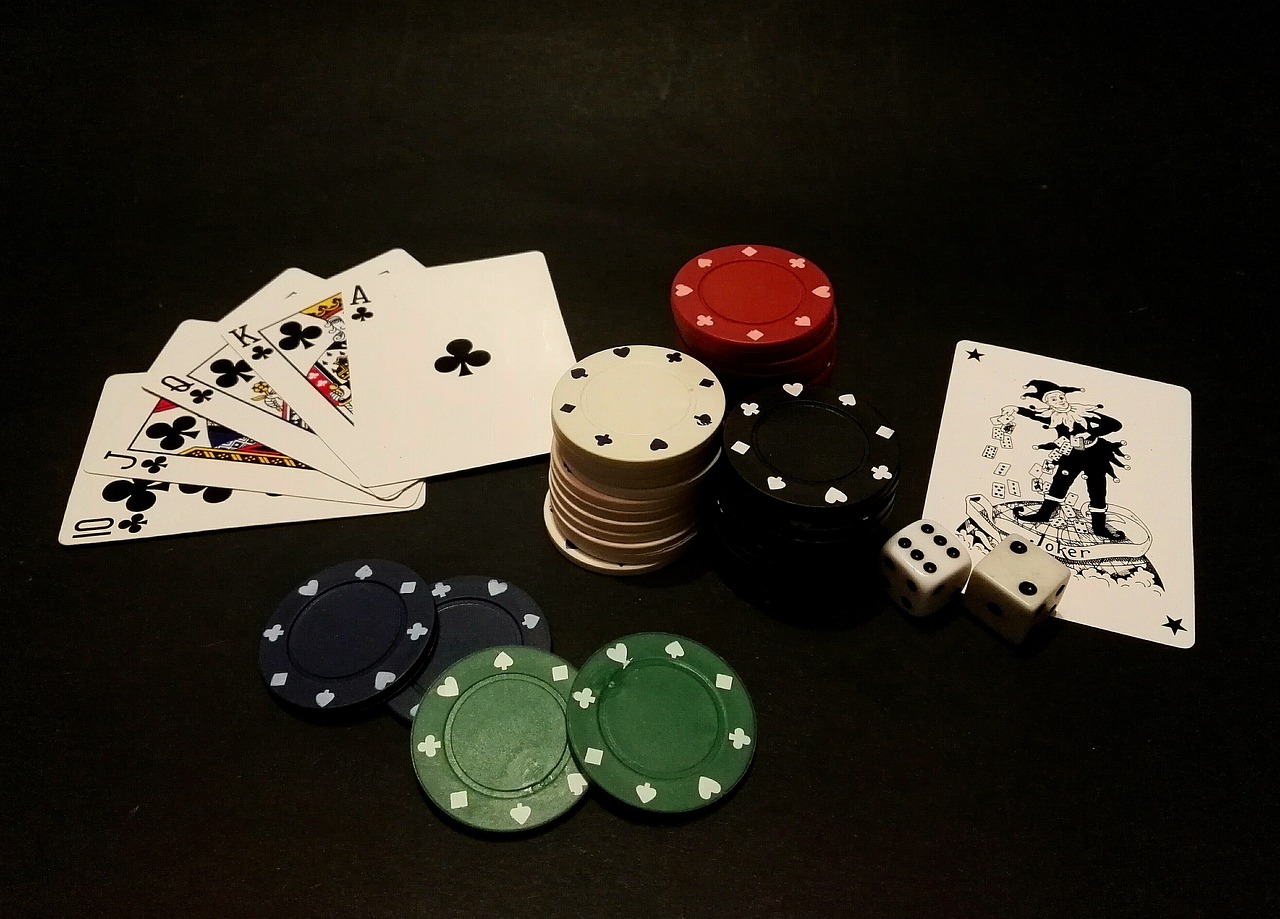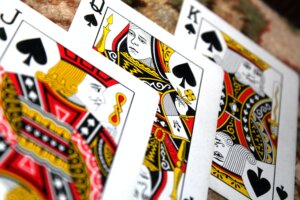Table of Contents
A Full House is a type of poker hand that consists of three cards of the same rank and two cards of another rank, such as three Queens and two 5s. This means that you’re holding two different hands – A Pair and Three of a Kind. This hand is ranked just below Four-of-a-Kind and above a Flush in the standard ranking of poker hands. The strongest Full House you can get is “Aces full of Kings,”; Three of a Kind Aces, and a Pair of Kings.
How to Make a Full House in Poker
Making a Full House in poker is easier than it sounds. As we established in the intro, you only need three of a kind and a pair.
The best way to make a Full House is by using all five cards on the table. In other words, if three Kings and two Queens are on the table, anyone with any other card can make a Full House. However, if there are only two Kings and two Queens, you need to hold one of each to make a Full House.
Ranking a Full House Hand

The ranks of the cards on a Full House hand are used to determine their value. The higher the rank of the three matching cards, the higher the value of the Full House. For example, a Full House containing three Aces and a Pair of 2 would be worth more than a Full House containing Three of a Kind 2s and a Pair of 3.
When two or more players hold a Full House, the player with the highest ranking, Three of a Kind wins. In our example above, the player with Three of a Kind of Aces would win in a case where multiple players had Full Houses.
How Do Full House Hands Compare on a Poker Hand Ranking?
Poker-hand rankings are classified by the strength of the different hands that can be played in a game of poker and are considered an essential aid for in-game decision-making.
A Full House hand is ranked #4 on the poker hand rankings list, only beaten by a Royal Flush, Straight Flush, and Four of a Kind.
Probabilities and Odds of Forming a Full House in Poker
The odds of getting a Full House in poker mainly depend on the number of decks used and the game variant being played. For example, for Texas Hold ’em, the probability of getting a Full House is approximately 2.60% or 1 in 38 hands. Whereas, for Omaha, the likelihood of getting a Full House is slightly lower, at approximately 2.45% or 1 in 41 hands.
There are a few different ways to calculate the probability of being dealt a Full House hand during a game of poker, but the most common method is to use the “combination” formula. This formula calculates the number of ways that a given hand can be formed and then divides that number by the total number of possible hands that can be dealt.
There are 5 choices for the first card, 4 choices for the second card, 3 choices for the third card, and 2 choices for the fourth card. This gives us 5 x 4 x 3 x 2 = 120 different ways to form a Full House. However, there are 52 cards in a deck, so we need to divide 120 by 52 to get our final answer: 120/52 = 2.3%
Tips for Playing with a Full House in Poker
If you’re lucky enough to be dealt a Full House, here are some tips on how to play it:
- Determine the strength of your Full House: If you have a Full House, it’s important to determine how strong it is. For example, a Full House of Aces full of Kings is stronger than a Full House of Queens full of 3s.
- Assess the table: Check the table for potential flushes or straight draws that can beat your Full House. If the table is paired, be aware of potential quads that can beat your hand.
- Consider your position: Your position at the table can influence your strategy with a Full House. If you are in an early position, it may be best to bet or raise to narrow the field and protect your hand. If you are in a later position, you can check or call to induce other players to bet.
- Watch your opponents’ actions: Pay attention to your opponent’s actions and betting patterns to determine if they have a strong hand or are bluffing. If your opponents are betting aggressively, it may indicate that they are holding a strong hand.
- Bet for value: A Full House is a strong hand, so you should try to extract as much value as possible from it. However, be careful not to overbet and scare off other players.
- Don’t get too attached: Even with a Full House, several hands can still beat you. Don’t get too attached to your hand; be prepared to fold if necessary.
Playing Strategies for Full House Hands

Playing full house hands in poker demands a strategic mindset that takes various aspects into consideration. These include your seating position at the table, the playing tendencies of your opponents, and the broader game context.
Before fully committing to a full house, it’s essential to carefully examine the community cards on the board. This examination should involve assessing whether there are any potential higher-ranking hands, such as straights or flushes. If the board layout seems favorable for a full house and less likely to result in a stronger hand, the value of your full house increases significantly. Your position relative to the other players at the table plays a pivotal role in shaping your decision-making. In early positions, a more cautious approach might be prudent, whereas in later positions, you can adopt a more aggressive stance when holding a strong hand like a full house.
Understanding the playing styles and tendencies of your opponents is crucial. If you detect signs that your opponents are holding strong hands, it might be wise to play passively to extract maximum value. Conversely, if your opponents seem to have weaker hands, you could explore the option of engaging in more aggressive betting to build up the pot. Deciding on the size of your bets should be influenced by the stage of the game and the relative strength of your opponents’ hands. While a full house is a potent hand, it’s important to strike a balance between building the pot and avoiding excessive over-betting, which could intimidate opponents into folding.
Common Mistakes to Avoid with Full House Hands
One common mistake is getting overly excited by a full house and overplaying it. While a full house is a strong hand, it’s not invincible, and there’s always a chance that your opponents have a better hand, like a four of a kind or a higher full house. Avoid going all-in too quickly without considering the possibilities of stronger hands.
Failing to pay attention to the texture of the community cards on the board is a mistake. If the board is showing potential for a flush or a straight, it’s important to consider that your full house might not be the best hand. Be cautious and evaluate the overall potential for stronger hands that your opponents could hold. Neglecting to read your opponents’ behavior and playing tendencies can lead to misjudgments. If an opponent suddenly becomes aggressive or shows signs of strength when you have a full house, it’s essential to assess whether they might have a better hand. Pay attention to their actions and adapt your strategy accordingly.
Every poker table has its own dynamics. Ignoring these dynamics and applying a one-size-fits-all strategy with a full house is a mistake. Adapt your approach based on the skill level and playing styles of your opponents, as well as the overall flow of the game. Position matters in poker, and not taking it into account when playing a full house can be detrimental. Playing too aggressively or too passively solely based on your hand without considering your position relative to other players can lead to missed opportunities or unnecessary losses.
Variations in Different Poker Games

Different variations of poker games can have unique rules and hand rankings, which can sometimes affect the definition and value of a full house. In Texas Hold’em and Omaha, which are two of the most widely played poker variants, a full house is generally defined as three cards of the same rank combined with two cards of another rank. The value of the three-of-a-kind component determines the rank of the full house. The specific variations arise from the community cards dealt and the hole cards held by players. In Seven Card Stud, players are dealt seven cards individually, and a full house is formed by having three cards of one rank and two cards of another rank. However, in this variant, since each player has their own set of cards, the competition for a full house can be different from community card games like Hold’em.
Razz is a lowball variant of Seven Card Stud, where the lowest hand wins. In Razz, a full house isn’t a strong hand but rather a weak one. A full house in Razz would be made up of three cards of one rank and two cards of another rank, but since the objective is to have the lowest hand possible, a full house isn’t desirable. In this lowball variant of draw poker, players strive to have the lowest possible hand. A full house is still ranked based on the value of the three cards of the same rank and the two cards of another rank, but the goal is to avoid strong hands in favor of weaker ones.
Full House vs. Other Strong Poker Hands
Understanding the ranking of a full house among other strong poker hands is crucial for informed gameplay. A full house ranks below four of a kind but surpasses hands like flushes, straights, two pairs, one pairs, and high cards. It’s composed of three cards of one rank and two of another, making it stronger than three of a kind or two pair. While formidable, a full house is still outranked by top-tier hands like royal flushes, straight flushes, and four of a kind. Recognizing these rankings empowers players to make better decisions during poker games.
FAQs
How difficult is it to form a full house in poker?
Forming a full house in poker is moderately difficult as it requires combining three cards of one rank with two cards of another rank. While it’s not as rare as some of the top-tier hands like straight flushes or royal flushes, it still requires specific card combinations and favorable community cards to come together.
What is the ranking of a full house in poker versus other ranks?
In the standard hand ranking hierarchy of poker, a full house ranks above hands like flushes, straights, two pairs, one pair, and high cards, making it a strong combination. However, it falls below the ranks of four of a kind, straight flushes, and the highest-ranking hand, the royal flush.
What are the odds of getting a full house in poker?
The odds of obtaining a full house in poker depend on the specific game variant being played, the number of players, and the community cards dealt. In Texas Hold’em, for example, the odds are roughly 1 in 694, but they can vary in other variants such as Omaha or Seven Card Stud.






